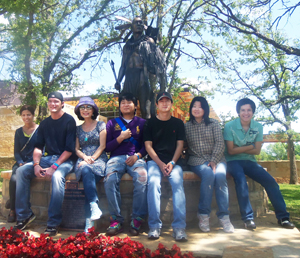ESL students visit Oklahoma’s historical sites


Photos Courtesy Abra Figueroa
English as a second language students Fikirte Hagos, Chase Blankenship (News Writing student), Meesook Shin, Seokmun Sona, Hyundu Kim, Eunsook Seo and Jorge Castillo pose for a picture, April 10 at the Chickasaw National Park.
Looking at the past is one way to help international students understand the culture of the state where they currently live.
That’s one reason why six students in the English as Second Language bridge program spent a lovely spring day on a field trip to the Sulphur Springs area, home of the Chickasaw Nation.
On April 10 the students learned about the Chickasaw way of life and how the Indians lived off the land.
“We are going to have a great day,” said Professor Abra Figueroa, director of the English as a Second Language program, at the beginning of the trip.

Photos Courtesy Abra Figueroa
Members of the OCCC ESL group cross the Little Niagra near Sulphur, Okla. The annual trip to Sulphur includes a visit to the Chickasaw Nation and the Arbuckle Historic Museum.
The ESL bridge group first stopped at “Little Niagara” in Sulphur, which is a natural spring that flows through the Chickasaw National Park.
The students were able to take pictures by the spring and explore the nearby trails.
“This area reminds me a lot of where I grew up in Korea. The scenery is fairly similar,” said student Meesook Shin.
The students then made their way to the Chickasaw Cultural Center, also located in Sulphur. The Center is a museum evolving around the Chickasaw heritage and traditions.
Upon arrival at the museum, the group met up with their tour guide, Judy Donaho.
Before the tour began the students were welcomed through song and dance, followed by an invitation to participate in these traditional Chickasaw activities. Donaho then took the students through the museum and told stories of the Chickasaw Nation.
During the tour, the students first learned about the history of the Chickasaw people, and then they were able to examine and experience the actual living conditions that the Chickasaws knew in the 17th century.
While standing on an elevated bridge, the students overlooked a cluster of tribal homes.
“The part that I liked most was the bridge, staying up there,” said Jorge Castillo, a student from Mexico. “You can see nature and you can imagine how the Indians lived.
“Being able to overlook the whole village from the bridge was a way of seeing the “big picture.” he said.
The students made the final stop of their field trip in Davis, at the Arbuckle Historical Museum. This museum was formerly the Davis Santa Fe Depot. Records indicate the train station was operational as early as 1908.
Now a museum, one can find artifacts such as medicine, crafts, tools, clothes and railroad memorabilia.
Students were able to grasp the racial segregation of public accommodations in Oklahoma before the Civil Rights movement, as well as the operation of an early 20th century train station. Toilets and drinking fountains bore labels that read “whites only” and “colored.”
From the artifacts and their history, the students were able to gain knowledge and a perspective about Davis and the surrounding lands.
“I have never liked museums before, but I loved this one,” said student Fikirte Hagos from Ethiopa. “It was different.”
Seokmun “Jacob” Song, Hyundu Kim, and Eunsook Seo also participated in the field trip.
To contact Chase L. Blankenship, email onlineeditor@occc.edu.